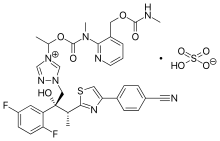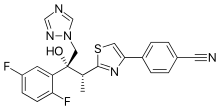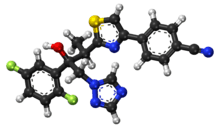Isavuconazonium
Isavuconazonium sulfate, sold under the brand name Cresemba, is a systemic antifungal medication of the triazole class which is used to treat invasive aspergillosis and mucormycosis.[1][2][3]
 | |
| Clinical data | |
|---|---|
| Trade names | Cresemba |
| AHFS/Drugs.com | Cresemba |
| Pregnancy category |
|
| Routes of administration | By mouth, intravenous |
| Legal status | |
| Legal status |
|
| Identifiers | |
| CAS Number | |
| ChemSpider | |
| KEGG | |
| CompTox Dashboard (EPA) | |
| Chemical and physical data | |
| Formula | C35H35F2N8O5S |
| Molar mass | 717.77 g·mol−1 |
| 3D model (JSmol) | |
SMILES
| |
InChI
| |
| | |
 | |
 | |
| Clinical data | |
|---|---|
| Trade names | Cresemba |
| Other names | BAL8557 |
| ATC code | |
| Identifiers | |
IUPAC name
| |
| PubChem CID | |
| ChemSpider | |
| UNII | |
| KEGG | |
| ChEBI | |
| ChEMBL | |
| NIAID ChemDB | |
| CompTox Dashboard (EPA) | |
| Chemical and physical data | |
| Formula | C22H17F2N5OS |
| Molar mass | 437.47 g·mol−1 |
| 3D model (JSmol) | |
SMILES
| |
InChI
| |
| | |
Isavuconazonium is a prodrug of isavuconazole.
Medical uses
Isavuconazonium is used to treat invasive aspergillosis and invasive mucormycosis in adults ages 18 years and older. It is available in a capsule for administration by mouth and as a powder for administration via infusion.[1][2][3][4]
Contraindications
Isavuconazonium should not be given to anyone with a history of allergic reaction to it, nor to anyone taking ketoconazole or high-dose ritonavir. It should not be given to anyone with a family history of short QT syndrome. It has not been tested in children.[2]
In preclinical studies, isavuconazonium caused birth defects; it has not been tested in pregnant women. Women who are pregnant should not take it and women taking it should not get pregnant. It is excreted in breast milk so people should not breast feed while taking it.[2]
Side effects
Common adverse effects (occurring in between 1 and 10% of people) include low potassium, decreased appetite, delirium, headache, sleepiness, vein inflammation, difficulty breathing, acute respiratory failure, vomiting, diarrhea, nausea, stomach pain, elevated results in liver function tests, rash, itchy skin, kidney failure, chest pain, and fatigue. There are several uncommon side effects as well.[2]
Interactions
Isavuconazonium is converted into isavuconazole inside the body, and isavuconazole is a substrate for CYP3A4 or CYP3A5. Many other medications inhibit or induce those two enzymes, and isavuconazonium should not be administered with them. Inducers result in levels of isavuconazole that are too low and won't work, and inhibitors can cause high levels of isavuconazole which will in turn cause increased adverse events and toxicity. Likewise isavuconazonium can interfere with appropriate dosing of other drugs that are substrates for those enzymes.[2]
In addition, isavuconazole induces CYP2B6 and can decrease the amount of drugs that are metabolized by the enzyme. Isavuconazole inhibits P-glycoprotein (P-gp), BCRP, SLC22A2, and uridine diphosphate-glucuronosyltransferases, each of which remove drugs from circulation; isavuconazonium will increase the amount of drugs that are affected by those proteins and may increase their toxicities.[2]
Pharmacology
After oral or IV administration, isavuconazonium is rapidly hydrolysed by esterases in blood or the gastrointestinal tract to the active form, isavuconazole.[2][5]
Isavuconazole works by inhibition of lanosterol 14α-demethylase, the enzyme responsible for converting lanosterol to ergosterol by demethylation. The resulting depletion of ergosterol and buildup of lanosterol compromise the structure of the fungal cell membrane. Mammalian cells are resistant to demethylation inhibition by azoles, making the drug effects specific to fungi.[2][5]
Chemistry
Isavuconazonium comprises an N-(3-acetoxypropyl)-N-methylamino-carboxymethyl group linked through an ester moiety to the triazole nitrogen in isavuconazole.[6][7][8]
History
Isavuconazole and isavuconazonium were discovered in Japan by researchers at Roche's research center in Kamakura.[6][9] Basilea Pharmaceutica, which had been spun out of Roche to develop antimicrobial assets, developed isavuconazonium through Phase II clinical trials. In February 2010, Basilea partnered with Astellas Pharma to complete Phase III trials, obtain regulatory approvals, and market the drug. In 2013 and 2014 the partners won orphan drug designation in the US for isavuconazonium for treating invasive aspergillosis, mucormycosis, and invasive candidiasis.[5]
In 2014 Basilea and Astellas amended the agreement to give Astellas sole marketing authority in North America, and Basilea the rights to market in the rest of the world.[10]
The FDA granted approval in March 2015[5] and the EMA approved it in October 2015.[2]
In 2017 Basilea licensed rights to Pfizer to sell in most of Europe and a few other countries.[11]
References
- "US Cresemba label" (PDF). FDA. March 2015. Retrieved 3 July 2017. For label updates, see FDA index page for NDA 207500 (capsule form) and for NDA 207501 (IV form)
- "Cresemba 100 mg hard capsules - Summary of Product Characteristics (SPC)". UK Electronic Medicines Compendium. February 2017. Retrieved 3 July 2017.. "Cresemba 200 mg powder for concentrate for solution for infusion. Summary of Product Characteristics (SPC)". UK Electronic Medicines Compendium. February 2017. Retrieved 3 July 2017.
- Donnelley, Monica A; Zhu, Elizabeth S; Thompson, George R (2016-06-02). "Isavuconazole in the treatment of invasive aspergillosis and mucormycosis infections". Infection and Drug Resistance. 9: 79–86. doi:10.2147/IDR.S81416. PMC 4898026. PMID 27330318.
- Miceli, MH; Kauffman, CA (15 November 2015). "Isavuconazole: A New Broad-Spectrum Triazole Antifungal Agent". Clinical Infectious Diseases. 61 (10): 1558–65. doi:10.1093/cid/civ571. PMID 26179012.
- Pettit, Natasha N.; Carver, Peggy L. (2015-07-01). "Isavuconazole A New Option for the Management of Invasive Fungal Infections". Annals of Pharmacotherapy. 49 (7): 825–842. doi:10.1177/1060028015581679. PMID 25940222.
- Guinea, J; Bouza, E (December 2008). "Isavuconazole: a new and promising antifungal triazole for the treatment of invasive fungal infections". Future Microbiology. 3 (6): 603–15. doi:10.2217/17460913.3.6.603. PMID 19072177.
- "Proposed INN: List 96" (PDF). WHO Drug Information. 20 (4). 2006.
- "Recommended INN: List 58" (PDF). WHO Drug Information. 21 (3). 2007.
- Ohwada, J; Tsukazaki, M; Hayase, T; Oikawa, N; Isshiki, Y; Fukuda, H; Mizuguchi, E; Sakaitani, M; Shiratori, Y; Yamazaki, T; Ichihara, S; Umeda, I; Shimma, N (20 January 2003). "Design, synthesis and antifungal activity of a novel water soluble prodrug of antifungal triazole". Bioorganic & Medicinal Chemistry Letters. 13 (2): 191–6. doi:10.1016/s0960-894x(02)00892-2. PMID 12482421.
- "Astellas Takes Over Isavuconazole Manufacturing and Promotion in U.S., Canada". Genetic Engineering & Biotechnology News. February 28, 2014.
- Elvidge, Suzanne (June 16, 2017). "Pfizer builds out anti-infective reach with Basilea deal". BioPharma Dive.